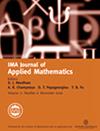环格上局部化模式的Snaking分岔
IF 1.4
4区 数学
Q2 MATHEMATICS, APPLIED
引用次数: 5
摘要
我们研究了在具有对称耦合结构的环上提出的双稳态晶格动力学系统在小耦合强度条件下的稳态模式结构。我们证明了稀疏耦合(例如,最近邻或次最近邻耦合)和全对全耦合会导致显著不同的解分支。特别地,稀疏耦合导致具有许多鞍节点分叉的蛇形分支,而全对全耦合导致具有六个鞍节点的分支,而与图中节点数量的大小无关。本文章由计算机程序翻译,如有差异,请以英文原文为准。
Snaking bifurcations of localized patterns on ring lattices
We study the structure of stationary patterns in bistable lattice dynamical systems posed on rings with a symmetric coupling structure in the regime of small coupling strength. We show that sparse coupling (for instance, nearest-neighbour or next-nearest-neighbour coupling) and all-to-all coupling lead to significantly different solution branches. In particular, sparse coupling leads to snaking branches with many saddle-node bifurcations, while all-to-all coupling leads to branches with six saddle nodes, regardless of the size of the number of nodes in the graph.
求助全文
通过发布文献求助,成功后即可免费获取论文全文。
去求助
来源期刊
CiteScore
2.30
自引率
8.30%
发文量
32
审稿时长
24 months
期刊介绍:
The IMA Journal of Applied Mathematics is a direct successor of the Journal of the Institute of Mathematics and its Applications which was started in 1965. It is an interdisciplinary journal that publishes research on mathematics arising in the physical sciences and engineering as well as suitable articles in the life sciences, social sciences, and finance. Submissions should address interesting and challenging mathematical problems arising in applications. A good balance between the development of the application(s) and the analysis is expected. Papers that either use established methods to address solved problems or that present analysis in the absence of applications will not be considered.
The journal welcomes submissions in many research areas. Examples are: continuum mechanics materials science and elasticity, including boundary layer theory, combustion, complex flows and soft matter, electrohydrodynamics and magnetohydrodynamics, geophysical flows, granular flows, interfacial and free surface flows, vortex dynamics; elasticity theory; linear and nonlinear wave propagation, nonlinear optics and photonics; inverse problems; applied dynamical systems and nonlinear systems; mathematical physics; stochastic differential equations and stochastic dynamics; network science; industrial applications.

 求助内容:
求助内容: 应助结果提醒方式:
应助结果提醒方式:


